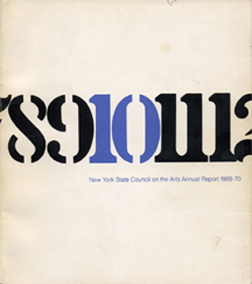| Publication Type | Book |
| Source | (1970) |
| Keywords | groups |
https://arts.ny.gov/sites/default/files/Annual%20Report%201969%20-%2070.pdf
|
Young filmmakers at Albany South End workshop, sponsored by Upper Hudson Library Federation. Photo:Kingsley Fairbridge |
Ed Emshwiller at filmmakers conference for elementary and high school teachers at Huntington, LI. Photo:Andree L. Abecassis |
|
|
Aldo Tambellini works with elementary school students at a television studio. Photo:WNYE-TV Channel 25 “Giving out old methods of information in this new media does not give us the possibility to discover its basic potential. We must consider that TV is audiovisual information at the speed of light. It is a light-sound instrument able to freely create and improvise its own forms. The immediacy of its audiovisual information makes possible spontaneous expression.” |
High school students screen their own films in Yorktown. Photo: Vincent Clarkin “We got things done fast because we wanted to see the results, not because some teacher said we ought to do it fast. Since we were trusted to take equipment out of the building whenever we needed to, I think we were more careful of it, because we cared what happened to it. We were allowed to experiment with the cameras, trying different effects, different ways of filming things…”
“I learned more about composition – written, oral and visual – than I learned in my two past years of High School English.” “For anyone even vaguely interested in film-making this course was a dreamer’s dream.” |
Elaine Summers’ Electric Kinetic Gymnasium at C.W. Post College on Long Island. “The plan is to immerse the walls in colliding superimposed images, intensifying the experience of movement as it occurs in athletics. There will be multitape bombardment, strobe light, and live music, and twenty-four projectrs will be used to dissolve the gym.” |
|
Young Filmmakers. The Film Club on Rivington Street on location. The Young Filmmakers Foundation, which has guided the Film Club program is one of three organizations chosen by the Council for pilot work in financial assistance. “Though public interest in the arts has increased markedly, the base of financial support has not broadened significantly. Because costs for labor and materials have risen, the gap between expenditures and income has widened. The new money needed to make up this difference has not been forthcoming, either in private contributions, or government subsidy.” – Howard Taubman, The New York Times. “A climate of anticipation – of more financial resources, of a more normal place in the economy, of wider public acceptance – has been engendered, and this climate on the one hand had made the search for funds more desperate and on the other has led the managers of artistic enterprises into unattainable plans for development.” – W. McNeil Lowry |
|
|
